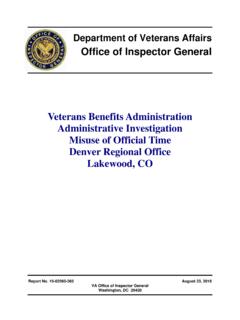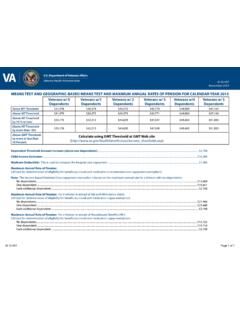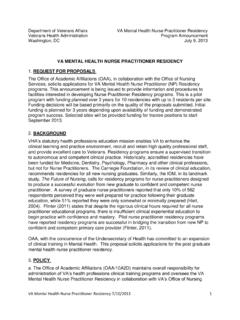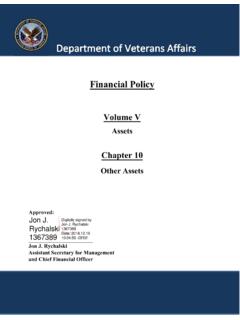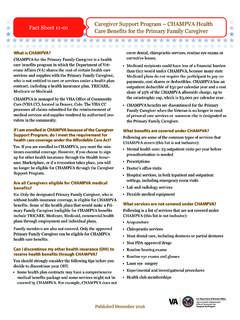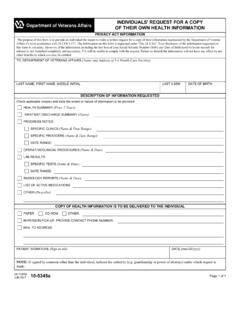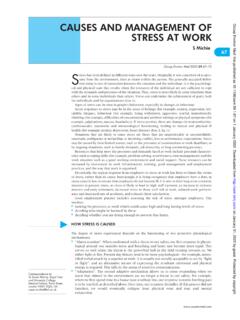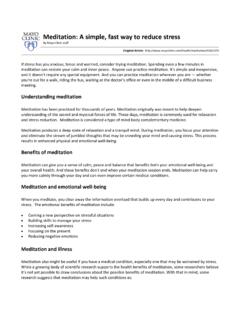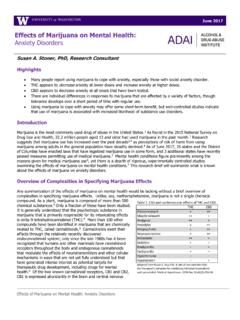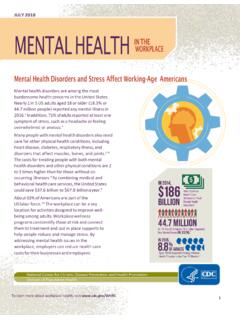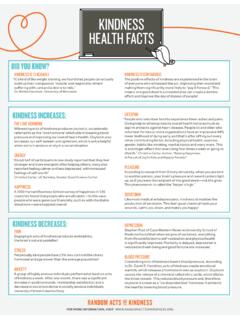Transcription of Effective Treatments for PTSD: Helping Patients Taper from …
1 Effective Treatments for PTSD: Helping Patients Taper from Benzodiazepines Quick Facts Taper anyone taking benzodiazepines for 2 weeks or longer Withdrawal symptoms may occur after only 2-4 weeks of treatment Risks of recurrence or rebound symptoms may occur as early as a few days to 1 week Concurrent use of other sedatives may alter withdrawals Benzodiazepines Overview Continuing to renew benzodiazepine (BZ) prescriptions to certain subgroups of your Patients with PTSD may be a high risk practice. These medications may no longer be of benefit to your Patients and carry significant risks associated with chronic use.
2 Due to the lack of evidence for their effectiveness in the treatment of PTSD, it is worthwhile for you to implement strategies for assessing Patients who are taking them to determine if a Taper is appropriate. It is also important to consider alternate treatment options and to minimize new benzodiazepine prescriptions whenever possible in the veteran PTSD population. This brochure offers you valuable resources to help you Taper your Patients from benzodiazepines and information on alternatives. Despite the involved challenges, strategies to Taper existing benzodiazepines prescriptions are Effective .
3 Before You Begin: A team-based approach will be most Effective in efforts to Taper a patient from benzodiazepines Build a stable relationship with your patient Evaluate and treat any co-occurring conditions Obtain complete drug and alcohol history and random drug screen Review recent medical notes (ER visits) and coordinate care with other providers If available, query prescription drug monitoring database Priorities: Tapering Existing Prescriptions Anyone on multiple BZDs or BZDs combined with prescribed amphetamines, and/or opiates Anyone with an active (or history of) substance abuse or dependence Anyone with a cognitive disorder or history of TBI Older veterans (risk of injury, cognitive effects) Younger veterans (better outcomes long term with SSRIs and evidence-based psychotherapies) 1.
4 43 Watts, Schnurr et al., 2013 Eff ect size (d) 0 Antidepressants Cognitive BehaviorTherapy Approximate Dosage Equivalents Elimination Half-life Chlordiazepoxide Diazepam Clonazepam Lorazpam Alprazolam Temazepam 1 mg 12-15 hr 30 mg 10-20 hr 25 mg >100hr 10 mg >100hr 1 mg 20-50 hr2 mg 10-20 hr Taper Recommendations Supratherapeutic Doses Consider admission due to greater medical risks Consider switching to long half-life drug (diazepam or clonazepam)
5 Reduce dose initially by 25-30% Then reduce dose by approximately 5-10% daily to weekly Consider anticonvulsant for high dose withdrawalTherapeutic Doses Bedtime Dosing (Qhs) Reduce by approximately 25% weekly Anticipate and educate regarding rebound insomnia which can occur as early as one day Provide reassurance and sleep hygiene information Initiate alternate treatment options: CBT-I, non-BZD agents Therapeutic Doses Daytime Dosing (generally QD to QID) Anticipate and provide education regarding rebound anxiety and recurrence of initial anxiety symptoms Plan additional psychological support during Taper Last phase of withdrawal is likely to be difficultAdditional Strategies for Complex Cases Can be helpful to be flexible with schedule Prolonged Taper >6 months may worsen long-termoutcome Consider stabilizing on 50% dose for several monthsbefore proceeding with Taper Consider switching to a long-acting BZD (particularlyhelpful with long-term use, Supratherapeutic doses, or short half-life BZDs)
6 Establish a team to support veteran (PCP, CaseManager, Therapists, Group Facilitators, Pharmacists, Residential Treatment, etc) Concurrent Opioids Co-prescribing of benzodiazepines and opiates can lead to pain related behavioral management problems and put your Patients at higher risk for fatal and non fatal overdose. Often prescriptions for these medications are given by different prescribers; work with your Patients and their other care providers to determine best treatment CBT CBT-I concurrent with Taper improved outcomes In Patients with panic disorder those who received 10 sessions of group CBT during slow Taper had 76% successversus 25% with slow Taper alone CBT concurrent with slow alprazolam Taper showed no difference in success of Taper , however, at 6-month followup, 50% of non-CBT group and none of CBT group had resumed BZDs Benzodiazepines are thought to hinder the benefits ofpsychotherapy.
7 Cognitive-behavioral therapy (CBT) is where your patient will get the biggest benefit Effect Size Chart Consider tapering one or both. Patients with increased Points of dosing schedule changes ( TID to BID) can anxiety may have a more difficult time with a be psychologically challengingbenzodiazepine Taper . Patients whose PTSD and pain are Encourage veteran to actively participate in developing related due to their trauma may have a more difficult timewithdrawal schedule when possible with an opioid Taper . Initial dose Taper typically between 10-25% Observe for signs of withdrawal An ticipate early withdrawal for BZDs with a short half-life Individualize subsequent reductions based oninitial responseGenerally, further reductions of 10-25% every 1-2 weeks are well tolerated pharmacologically.
8 May need to slow Taper and/or offer additionalpsychological support as veterans learn new ways ofcoping with their anxiety Generally any decrease in these medications is a move in theright direction. Let the patient guide you where to start. Adjunctive Options Adjunctive options explored to support the last phase of Taper : Mirtazapine (positive case studies), carbamazepine, showmixed results Propranolol, Progesterone, Ondansetron, TCAs, Valproate, Trazodone, Buspirone showed no difference Consider duloxetine or amitriptyline for pain Benzodiazepine Equivalent Doses and Suggested Taper Milestone Suggestions Effects of Treatment on PTSD Severity Example.
9 Alprazolam 2 mg bid Convert to 40 mg diazepam daily Week 1 35 mg/day Week 2 Total dose decrease by 25% 30 mg/day (25%) Week 3 25 mg/day Week 4 Total dose decrease by 50% 20 mg/day (50%) Week 5-8 Hold dose Continue at 20 mg/day for 1 month We e k 9 -10 Current dose reduction of 25% every two weeks 15 mg/day We e k 11-12 10 mg/day We e k 13 -14 5 mg/day Week 15 discontinue Benzodiazepine Taper : Switch to a longer acting benzodiazepine Reduce dose by 50% the first 2-4 weeks then maintain on that dose for 1-2 months then reduce dose by 25% Perry PJ et al.
10 Psychotropic Drug Handbook Philadelphia Lader M et al. CNS Drugs 2009 ; 23:19-31. every two weeks Copyright 2013 by the National Center for PTSD |


